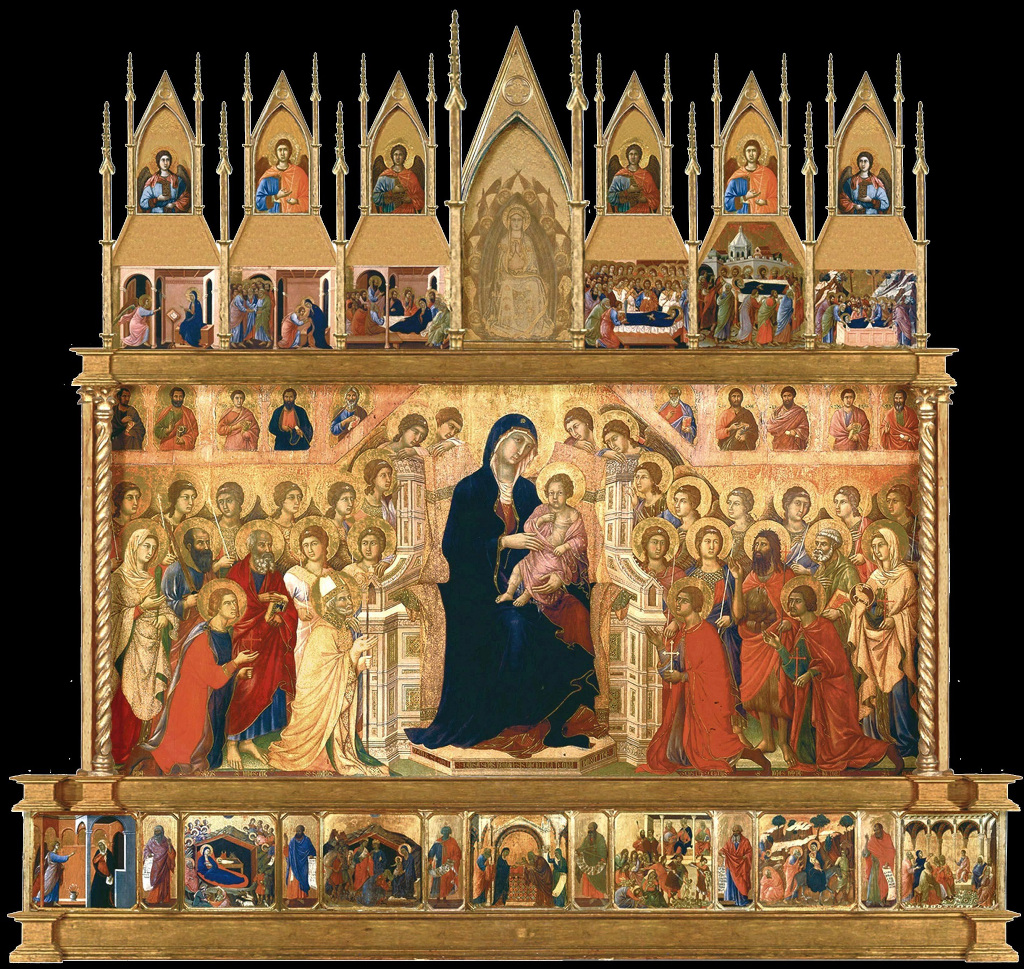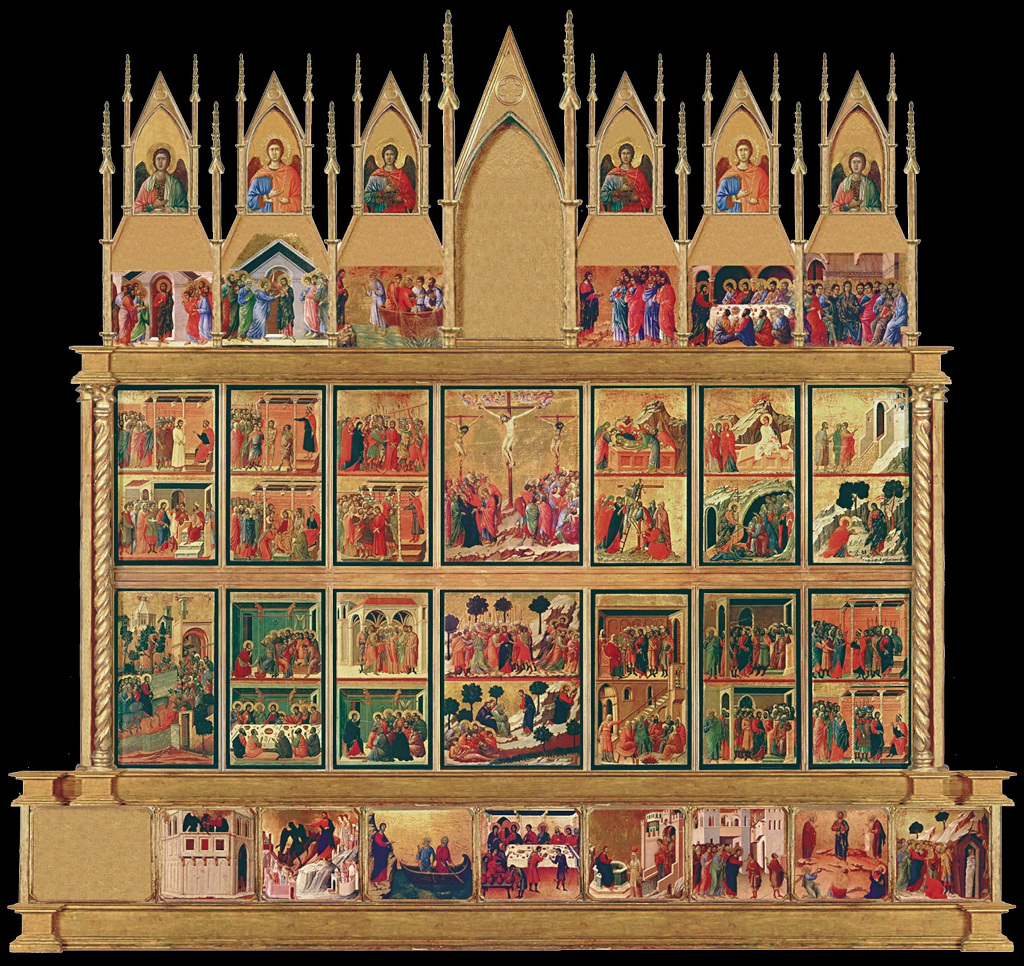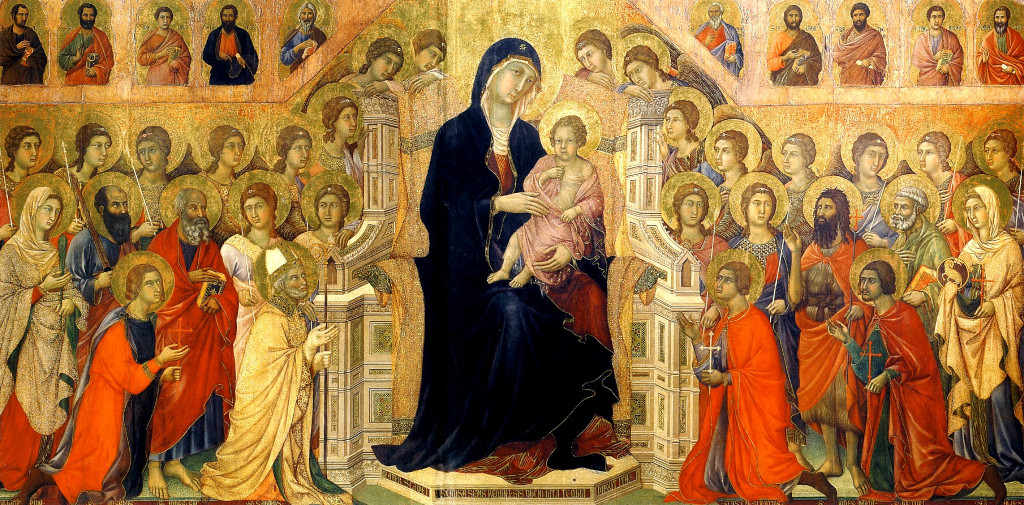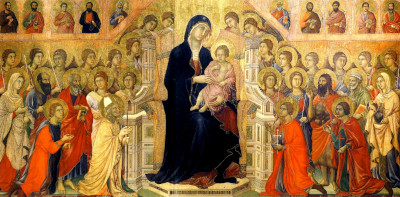Duccio's Maestà was a highly ambitious series of paintings completed in the early 14th century. The main component pictures an enthroned Madonna and Child with saints and angels, with the artist providing many more supporting artworks as part of a complex altarpiece design.
This creation was to become the artist's most famous painting of all, and help to evolve Italian art onwards from the previous era of Byzantine art. He would be joined by the likes of Giotto and Cimabue in bringing a greater sense of realism to art, and from their achievements the main Renaissance would be born. Duccio's majestic use of tempera and gold on wood captivated his audience and allowed the artist to acquire all manner of different commissions, right across Italy. He was Sienese, and this important artwork remains there today within the Museo dell'Opera Metropolitana del Duomo. The artist would spend three years in total working on this project, calling on the assistance of other members of his workshop in order to complete this challenging commission in a timely manner. A master such as this would always keep a close eye on proceedings in order to ensure that his own reputation would not be tarnished by others failing to meet his own high standards.
The highly elaborate design for the Maestà features a two-sided design, with many individual artworks gathered together on wooden panels. The Madonna and Child piece covers much of the front of the altarpiece, with a predella of small paintings in a row underneath and then a further set of artworks above. On the reverse there is then many dozen more small artworks which together complete the overall project. It was undeniably bold and ambitious, and a studio was used to facilitate the work before it was finally unveiled at Siena Cathedral in the summer of 1312. The installation position meant that the design would have to be across both sides of the wood panelling, and as breahtaking as that made the final artwork, it did complicate matters considerably. The artist and his assistants made use of a large studio in Via Stalloreggi from which to plan the logistics of this commission, which first starting with the arrangement of the wood panelling, prior to paint being applied.
It was eventually decided in the 18th century to dismantle the altarpiece, with some elements now residing abroad in the collections of various art galleries. Thankfully, plenty still remains within Siena and can be seen today in the Museo dell'Opera Metropolitana del Duomo, where much more information can be found about the original display. Duccio was a key Siena artist who helped to make others aware of the qualities of the art school found here. He would also spread the region's reputation elsewhere across Italy, and open new opportunities for its artists. The Sienese School was at its strongest between the 13th and 15th century, and became most respected for its impressive handling of the Madonna and Child, or Maestà, theme which it specialised in. Even Duccio alone captured this iconic image in a large number of paintings across his own career.
Table of Contents
- Description of the Painting
- What Techniques did Duccio use for Maestà?
- History behind Duccio's Maestà
- Who influenced Duccio's Maestà?
- Did the Artist Produce other Depictions of the Madonna and Child?
- How was the Altarpiece Constructed?
- When was the Altarpiece Dismantled?
- Where can the Paintings be Found Today?
- What other Artists came from Siena?
- What was the Siena School famous for?
- Explain the Content within Duccio's Maestà
- What other Artists featured the Maestà?
- What Paintings are Featured on the Front of the Altarpiece?
- What can we see on the Reverse of the Altarpiece?
- Large Image of Duccio's Maestà
Description of the Painting
Maestà features the enthroned Madonna and Child centrally and oversized. They are joined by a large selection of angels and saints who are spread out across the horizontal of this wide panel piece. This central panel is also sometimes known by the fuller title of The Mother of God Enthroned with the Christ Child Amidst Angels and Saints. The Madonna is dressed in a dark blue coat which covers her red dress and this is the normal colour combination used by artists of that time to depict this iconic figure. The child beside her is also in the trademark tones of pink, as he sits on his mother's left leg. The artist uses architectural style features across the ornate throne, almost as if painting a cathedral. In front and to the side are a number of kneeling guests, whilst others stand around the rest of the scene, filling the entire composition with a whole assortment of figures. They all look in admiration at the Madonna and Child, with their focus fixed as if in a trance.
The likes of Cimabue, Giotto and Duccio would often add halos in golden paint as if to signify the divine, and we see it here. They often then continued these tones across the background, helping to lift the overall piece and create impact when put on display within a religious setting. Duccio would likely have allowed his assistants to complete some of the supporting elements within this painting, perhaps then completing the Madonna and Child himself because of how that is the main focus of the piece. He understood that ambitious projects such as this could not be completed by one man alone, and so he would have to allow others to get involved. In the background, the room sweeps away to leave an additional row of figures behind, at the top of the composition. They are each afforded their own section to themselves, in a similar manner to how other 13th and 14th century artists had worked on themes such as this.
What Techniques did Duccio use for Maestà?
Duccio would use tempera and gold on wood for most of his career. The alternative method during this period of Italian art was for fresco work directly on plaster. This artist liked to cover his backgrounds in golden paint, before using tempera for the main content. The Sienese painter was heavily influenced by the traditional style of Byzantine art but started to evolve this onwards, with his advancements being continued by the next generation of Siena artists. This group would play a key role in moving us towards the earliest stages of the Italian Renaissance, where content started to become more realistic and left behind the flattened imagery of before. That said, Christian iconography remained dominant and depictions of the Maestà would be found for several centuries beyond this point, even into the Baroque. Duccio's techniques inspired his own students who helped to establish a clear vision within the art of Siena.
History behind Duccio's Maestà
The artist set up a workshop and studio just around the corner from where it was to be displayed upon completion. In Via Stalloreggi they would design this complex piece, first arranging the wooden panels before then applying paintings to both sides. It was a high profile piece and many locals would gather to see the final painting being carried to Siena Cathedral on the 9th of June, 1312. Logistically, this was a real challenge, with the central panel alone being many metres in width and height. The supporting elements were also highly intricate and to complete paintings on both sides added a considerable complexity to the overall project. All the hard work and ingenuity was to the benefit of local Sienese who could now admire this majestic creation from multiple angles. It brought pride to the city and helped to further establish this Italian region as a major force within the country's cultural scene.
Who influenced Duccio's Maestà?
Duccio is one of the few artists from the 13th and 14th century to have been particularly well documented, which is partly why so many artworks remain attributed to him today. We also, therefore, know a little more about the influences on his work than with others from around taht time. There has been discussion about how he became signficantly influenced by the sculpture of the Pisani and by French Gothic metalwork. We also know that Cimabue would himself inspire much of Duccio's progress too. The artist took what had gone before, which is broadly termed as the Italo-Byzantine tradition, and then fused it with a Gothic style to create something new which helped this period to evolve towards what would later become the early Renaissance. Duccio's brilliance and strong levels of innovation mean that there is much more information available on who he influenced, rather than vice versa.
Did the Artist Produce other Depictions of the Madonna and Child?
Siena was famous for its depictions of the Madonna and Child, an image which became known by many under the term, Maestà. Just Duccio himself would make use of this iconic content many times over within his career, and this demand was further fuelled by the success and fame of the particular panel found here. Madonna and Child and the Rucellai Madonna are clearly his other famous contributions, but many more can be found. It took many centuries before his work was correctly attributed, and even today there remains question marks over some, but the true highlights of his career are confidently known to be his. The Sienese would normally be first in line for commissions of this nature, and Duccio's reputation put him right at the forefront of this. He took inspiration from past centuries and incorporated his own innovations and ideas to move this theme onwards once more. The Maestà found here remains his most important achievement of all and remains one of the masterpieces of the Proto-Renaissance.
How was the Altarpiece Constructed?
A studio was organised for Duccio and his assistants which lie just around the corner from the cathedral in which the piece would later be displayed. Time was initially spent constructing the wooden panels, which was quite a task in itself. Once the elaborate sections had been firmly attached to the main panel, then the task was to complete the paintings on both sides. Even with the considerable assistance that he received, it still took several years for these artworks to be finished. The artist would then review the work of his assistants and make adjustments as necessary, before finally the whole structure was carried through the streets of Siena and carefully put in place in the Cathedral's altarpiece. It would remain there for several centuries and was considered to be a major draw to the city for those interested in art at that time. It also inspired other local people to become involved in this trade themselves.
When was the Altarpiece Dismantled?
Sadly, it was decided to break up this momentous piece in 1771, perhaps due to its size which was now considered somewhat unwieldy. From this point onwards, some of the smaller pieces would become dispersed right across the world and other elements of the original altarpiece became significantly damaged. It is impossible to imagine such a scenario occurring today, such is the important of this painting. Thankfully, the Duomo museum in Siena still retains a large amount of the original design, including the main central panel and these items can all be viewed by the public. Its inclusion within this new location should also help to preserve what's left for future generations to enjoy. The elements which are no-longer in Siena can be found in various locations across the United States as well as a number of European countries, such as Spain, Netherlands, UK and Hungary.
Where can the Paintings be Found Today?
The vast majority of the original project, thankfully, remains in Siena at the Duomo Museum. The National Gallery in London hosts smaller pieces such as The Annunciation, Healing of the Blind Man and The Transfiguration. In Budapest you will be able to find The Coronation of the Virgin, with Christ and the Samaritan Woman to be found in the respected Museo Thyssen-Bornemisza in Madrid. Whilst it is highly unfortunate that the original display is no-longer intact, there is the unintended benefit that more Europeans and Americans are now able to see original items from Duccio's career without having to travel specifically to the Italian city of Siena. The US-based items include Isaiah, Nativity, Ezekiel and Calling of SS. Peter and Andrew in the National Gallery of Art, Washington, DC as well as The Raising of Lazarus in the Kimbell Art Museum in Fort Worth, Texas.
What other Artists came from Siena?
The Sienese School was at its most prominent and successful between the 13th and 15th century. Duccio, of course, would be the most important name to derive from him, but one of his students, Simone Martini, was also a highly accomplished artist himself. Some of the other contributors from Siena included brothers Pietro and Ambrogio Lorenzetti, Domenico and Taddeo di Bartolo, Sassetta and also Matteo di Giovanni. It is fair to say that Duccio started things off with his own achievements which helped to draw focus to the city and bring opportunities to others who followed on afterwards. Crucially, the newer generation would take Duccio's achievements and move things on once more, drawing in influences from Florentine art. The city itself became economically strong over this period which allowed more commissions to offered to local painters, sculptors and architects.
What was the Siena School famous for?
There were several stylistic and compositional features which became closely linked with the Siena School. The artists from this city tended not to take on genres such as portraiture and mythology, for example. They would also became recognised for using a particularly large amount of decorative touches within their paintings, as well as tending to prefer a richer palette. Duccio would have influenced much of this, with artists from his studio inevitably continuing his approach long after he had passed. Perhaps his Maestà is therefore fairly consistent with these traits of the region, with the depiction of the Madonna and Child also being more common within the content of Sienese artists than anywhere else in Italy. The region became highly regarded and drew in commissions from outside the city's boundaries, becoming seen as a specialist in certain Christian themes. This was a considerable achievement considering the competitiveness of Italian art at the time, with considerable names appearing in other cities such as Florence, Milan, Rome and Venice.
Explain the Content within Duccio's Maestà
The Madonna and Child would be amended symbolically, both in terms of size but also placement. Within many depictions of the Maestà, including Duccio's here, you will notice that the figures are very large in comparison to the supporting figures besides them. They have also been enthroned and lifted higher up the artwork, with others looking upwards towards them. Both of these stylistical choices were intended to underline the significance of Madonna and the Child to the painting itself, but also the Christian faith more generally. The angels and saints would hold strong gazes, being in awe at the mere sight of these important people. There would also be certain ways in which to paint the Madonna and Child that many artists used, such as the choice of colours for clothing, and also the ways in which they would interact with each other. These same topics would then change over time as we moved from one art movement to the next.
What other Artists featured the Maestà?
The Madonna and Child featured heavily within Sienese art, but also across Italian art more generally. It was prevalent across all stages of the Renaissance and into the Baroque as well. Whilst the content remained the same, stylistically there was an evolution from the early artists of the Proto Renaissance, such as Giotto, Cimabue and Duccio, towards those in the centuries that followed. In terms of those particular names, the same content appears in Cimabue's Maestà and Santa Trinita Maestà, where as Giotto produced Ognissanti Madonna and Madonna and Child. You will find many more examples within the Siena School, particularly with the artists who trained directly under Duccio himself, such as Simone Martini. This iconic image is perhaps the most recognised feature found within the Proto Renaissance, which itself would greatily influence the later periods of the Italian Renaissance.
What Paintings are Featured on the Front of the Altarpiece?

What can we see on the Reverse of the Altarpiece?

Large Image of Duccio's Maestà





